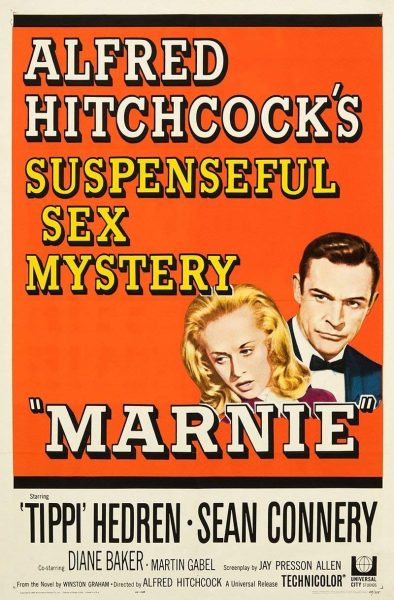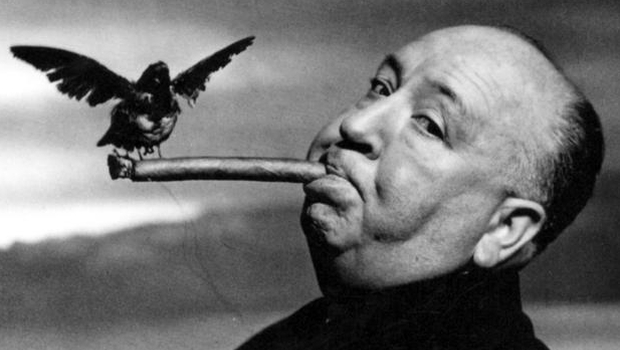Catching up with Alfred Hitchcock’s Spellbound after nearly 10 years and watching his Marnie next day for the first time reaffirmed my faith in the master as a storyteller; but somehow I could not escape the feeling this time that his films looked a little cold. It set me thinking for a while; what was amiss after all these years? His films still had the same hold over me, the same emotional connect. Or is it something to do with his craft? Well, I gradually veered towards the conclusion that one major reason could be that since he spelled out all his shots in storyboards and hardly ever improvised on the set – the control freak that he was, his mise-en-scenes look too calculated and lack the necessary warmth, at least in these two films. He comes across as a relentless manipulator of his characters (and actors) and their movements, right down to the minutest detail; everything is wow-so-precise.
Spellbound (1945), starring the beautiful Ingrid Bergman along with a young Gregory Peck reinstates Hitchcock’s favourite theme of the ‘innocent man on the run’. It does not really matter that the story is couched in pop psychology that hardly stands up to today’s times; you are not really bothered when it is Hitchcock. He reduces Freud’s theory of psycho-analysis to its most simplistic application and employs Salvador Dali to do a dream sequence, which serves to explain the mystery in a manner that is unapologetically reductionist. Despite its artistry, the dream sequence looks too clinical and graphic and lacks the naturalness and spontaneity that one generally associates with dreams.
But all these factors do not deter you from enjoying the roller-coaster ride that Hitchcock takes you on. You are hooked from the word go and really want to know the mystery behind Gregory Peck’s amnesia and his firm conviction that he has killed a reputed doctor whose identity he has taken. The cops are also convinced about his alleged role in the murder and pursue him. There is only one person who does not believe in his guilt; and that’s the ethereal Ingrid Bergman because she has fallen for him at first sight and is blinded by her love for him. She keeps him company and helps him to escape and also tries to unravel the mystery along the way by counseling him to come to terms with his past that is responsible for his predicament. One wished one had a counsellor like her; life would be so fine, really.

Marnie, made almost 20 years later, in 1964 was supposed to be Grace Kelly’s comeback film but that didn’t work out. They had worked together in three consecutive films – Dial M for Murder and Rear Window (both made in 1954) and To Catch A Thief (1955). Grace Kelly was at this time married to the Prince of Monaco and for a princess to play the role of a frigid woman, and that too a thief ,would not have gone down well with the citizens of Monaco who loved their glamorous star-princess. So Hitchcock cast Tippi Hedren and a young Sean Connery, who had already done the first two James Bond films.
Marnie, like Spellbound also resorts to pop-psychology to crack its mystery. If in Spellbound it was Gregory Peck who had to be brought to terms with a sad incident in his childhood in order to solve the mystery by Ingrid Bergman, then here it is Sean Connery, who marries and helps a scheming thief (Tippi Hedren) to come to terms with a gory incident in her life when she was five years old so that she could get rid of her frigidity and her irresistible tendency to steal. In both the cases, the characters have no memory of the tragedies in their childhood and are tormented souls that need an external stimulus – and love, to come back to grips with life.
Of the two films, I prefer Marnie because of its ‘risqué’ theme – that of a woman who is a calculating thief and sexually frigid. Spellbound is too romantic and naïve – and simplistic; its crisis is external and you are hooked more by the physical chase when the couple is on the run. Marnie’s crisis is internal and morbid. It’s very difficult to root for a character who is a thief for no apparent reason but being the master that Hitchcock is, he makes it sure that our sympathies lie with the heroine even when she is in the act of stealing. Well, one major reason for it could also be that she is the heroine! One memorable scene that immediately comes to my mind is when Tippi Hedren stays back at her employer’s office when all other staff has left for the day: she opens the locker with a stolen key; we see the unsuspecting night watchwoman doing the rounds in the same shot in the background and gradually walk towards the zone where the theft is happening in the foreground, without the heroine being aware of the imminent danger. That scene is like a tour-de-force that keeps us on tenterhooks. How we fervently wish Tippi Hedren gets away with the theft fast as we count the gradual footsteps and our perceptible heartbeats!
Since I wrote this piece few weeks back, I happened to see Hitchcock’s Strangers on a Train once again on TCM recently. Made in 1951, it is based on a Patricia Highsmith novel of the same name. A professional tennis player – Guy is approached by Bruno – a fan of his, on a train journey who proposes that that they exchange murders: Bruno would kill Guy’s malicious wife because she is refusing to give him the divorce that he desperately wants so that he could marry his girlfriend, and in turn Guy should kill Bruno’s over-strict father. An indignant Guy rejects the insane proposal. But Bruno proceeds with his part of the plan; he strangles Guy’s wife in an amusement park and hounds Guy to kill his father now. But the cops have already started suspecting Guy because he is unable to provide a solid alibi…
Strangers on a Train is a quintessential Hitchcock ride with all the elements that mark his style: a taut screenplay, wicked humour, and his favourite theme of guilt passing onto the wrong man. I decided to look up the classic Hitchcock by Truffaut (which is like a veritable film school) to find out about the context and the background of the film and I stumbled into a section that serves to illustrate the master’s obsessive and immaculate control over his material.
Alfred Hitchcock: …I used to shoot the one piece of film in such a way that no one else could put the pieces together properly; the only way they could be edited was to follow exactly what I had in mind in the shooting stages. Selznick (the producer of the film) comes from the school of film-makers who likes to have lots of footage to play around with in the cutting room. Working as I do, you are sure that no one in the studio is going to take over and ruin your film…
Francois Truffaut: One senses that control in your pictures; it’s obvious that each shot has been made in a specific way, from a specific angle, and to run for a specific length of time. The only exceptions, possible, are courtroom scenes or scenes that require crowds.
Alfred Hitchcock: That’s inevitable, it can’t be helped. That’s what happened with the tennis match in Strangers on a Train, and it shows the risk in overshooting material. There’s too much footage for you to handle by yourself; you turn it over to the cutter to sort it out, but you never know what’s been left unused. That’s the risk.
So that’s the control freak for you. No wonder his style in retrospect looks a little too contrived occasionally, but of course you don’t mind. He catches you by the collar and manipulates your emotions in a manner that hardly leaves any room for any other interpretation other than what he wants you to see; he is a master at the game. Of course, I don’t mind being taken on for this kind of a ride and every time I watch a Hitchcock film, I gladly surrender myself to his wily machinations.



I think i disagree with ur view that hitckcock’s lack of warmth in his films (somehow i couldn’t write the word movie) makes them colder than today’s thriller/suspense movie. frankly i think the two can’t really be compared. to me, hitchcock’s films are a cerebral journey, whereas the today’s movie’s are all about a two hour fun ride.
i love the fact that hitchcock’s movie’s lack a lot of emotion it let’s you really focus on the story on the screen rather than actually try to be a part of it. hitchcock’s movie’s are not for everyone. obviously meant for a select audience. and i think that audience chooses that cold calculated approach to his films.
and i don’t think hitchcock’s films are meant for the viewer to identify with it’s characters. from what i absorb from his films, his movies are all about problems and solutions, crime and escape. there’s no good or bad. no judgment. with warmth, yu have emotion and with emotion, you have judgment.
his films do not try to make the audience cry or get angry or laugh, etc. i feel that they are meant to intrigue and suspend the usual set of perceptions, morality and philosophy of the audience. hitchcock merely presents a problem, it’s background and it’s ultimate end. and his focus being more on the psychology of the characters, would i think necessitate the need for an objective and clinical setting.
ok, so much for my own pop-psychology.
saswati
good piece ranjan. Selznick had 9 yr contract with Hitchcock ,but,they could make only 3 movies.(mind you Hitchcock was pretty prolific) producer ko apna kam karna chahiye aur director ko apna.
I’ve never heard this term pop-psychologist, but once I saw and interview, and the psychology explains that if a company hires a famous singer, for example Beyoncé, and she appears in the advertisements, it would be a successful campaign. And I look at these movie’s covers and definitely I love “Strangers on a train”.
Nice Piece